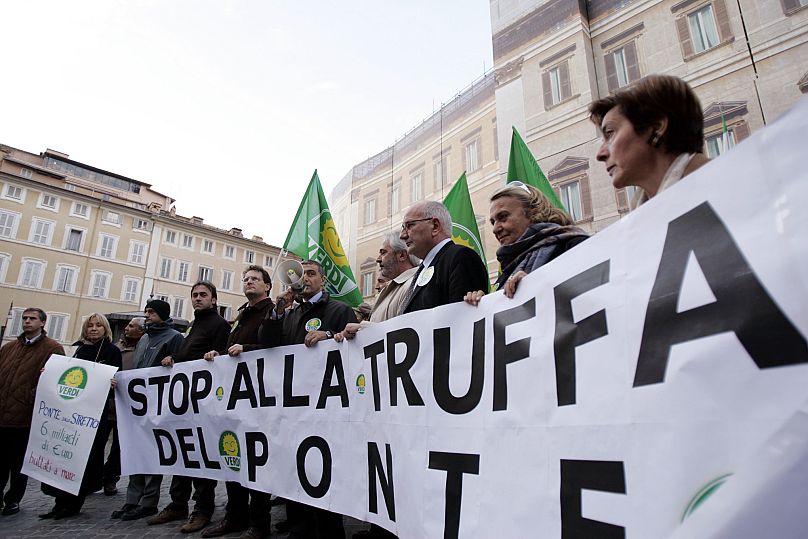Italian environmental activists say they will continue to fight against the construction of the bridge.
Plans to connect Sicily to the Italian mainland have come and gone for decades, with a bridge over the Messina Strait turning into an infamous myth for most Sicilians.
Twice a suspension bridge came close to construction in 2005 and 2011 under Silvio Berlusconi’s governments, but it was halted following protest from the World Wide Fund for Nature (WWF) and the European Commission as well as an economic crisis and political instability.
Now, Italian Prime Minister Giorgia Meloni has revived this project with a decree, in force since last March, backed by infrastructure minister and League party leader Matteo Salvini, with the laying of the first stone planned for 2024.
The plan has always been a nightmare for environmental activists: the Messina bridge would run through a natural reserve, a seismic area, and the construction site would lead to seizures of private land.
Even those who support the project, like Messina Mayor Federico Basile, are wary that this may be yet another empty promise. Many Sicilians see it as an ordeal that is about to start all over again.
‘Strange things tend to happen’
"I’m tired of the bridge. I spent so many years fighting against it," Anna Giordano, an activist for the WWF in Sicily, told Euronews.
Giordano and her colleague Stefano Lenzi brought the first case against the project, arguing that the bridge would be built on a protected area for birds at risk of extinction.
That prompted the European Commission to open an infringement procedure against Italy for breaking the EU’s environmental directives in 2005. Further research estimated that 4.3 million birds fly through the strait. According to a study, a fraction of the birds (between 17 to 46%) risked colliding with the bridge.
“For a species at risk of extinction, that equals killing half of all the exemplars,” said Giordano.
"Till this day, the government has never completed a thorough environmental impact assessment on the project," WWF Italy vice-president Dante Caserta told Euronews.
In 2011, the EU refused to fund the bridge, and even today EU recovery funds cannot be used for its construction. Salvini has unsuccessfully tried to persuade the European Commission to change its mind.
Tensions around the bridge have always been high with suspected Mafia infiltrations and even activists at times being put under surveillance.
Giordano recalled being harassed by the police during group meetings. “Strange things tended to happen back then,” she said.
In 2013, the economic crisis prompted the Mario Monti government to scrap the project, which resulted in decade-long litigation with the general contractor Eurolink, until the Meloni government restored the contract.
The cost of the infrastructure is now estimated at around €10 billion, up from the initial sum of €6.5 billion.
“The government has not explained how it will fund the bridge,” Daniele Ialacqua, a long-standing activist at Legambiente, Italy’s most prominent environmental group, told Euronews.
For Ialacqua, the project is in desperate need of European funds.
“But it won’t receive them, since the bridge goes against the zero emissions targets of the European Green New Deal,” Ialacqua said.
Legambiente Messina is asking Green MEPs to fight any Italian requests to fund the bridge in the future.
“In terms of money loss, it is the biggest failure in the history of this country,” said Caserta, adding that WWF Italy is ready to fight the Messina bridge for the third time.
'If the cost falls on us, it's a no'
Federico Basile, Messina's current mayor, argued that the bridge would help the development of the island.
"Though if the cost of building further infrastructure will fall on us and the region, then it is a no," Basile told Euronews, hoping the project won’t be another false start.
“We were planning the future of this city without considering the bridge - it better be certain. Its construction changes everything,” he argued.
Basile’s belief that the bridge will bring more investments to Sicily is shared by other local groups, like the one that Salvini League’s senator Nino Germanà recently founded: Ponte e Libertà (Bridge and Freedom).
Basile is confident that there can be a bridge that respects the nature of the Messina Strait, but local anti-bridge groups are sceptical and asked him to reconsider his position in a public letter.
‘We’ll stop it with our bodies’
“I am 69, and there have been talks about the bridge since I was a girl,” retired teacher Teresa Frisone told Euronews. She is part of Movimento No-Ponte, a network of groups against the bridge.
Like many activists, Frisone would prefer that authorities invest in the local rail and road network, which is heavily underdeveloped. She says that the bridge would not help commuters of the strait since the motorway toll would make it less convenient than the ferry.
A recent report by environmental group Legambiente argued that the strait could benefit from less expensive solutions, like investing in electric ferries to reduce pollution, following the example of the Baltic Sea region.
Frisone's main concern is about compulsory purchase orders. The construction of the bridge would require the opening of numerous construction sites.
Some communities, like Faro Point, would be cut in half, and the bridge would tower over them, with some parts as high as 400 metres.
"I’m afraid that they’ll just dig a construction site and then stop forever, leaving behind a skeleton and a few cement pylons, as it often happens in Sicily," Frisone said.
"We will do everything in our power to stop it, even with our bodies," she said.
Correction: An earlier version of this story misspelled the name of Teresa Frisone. It has been amended.












